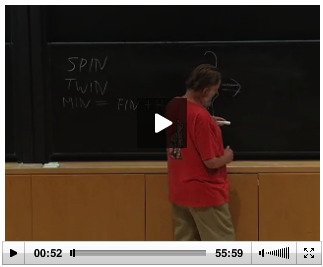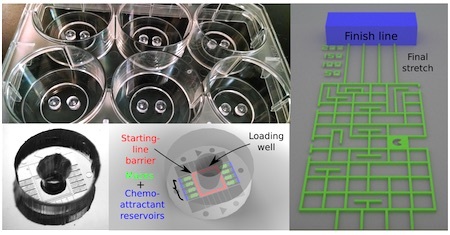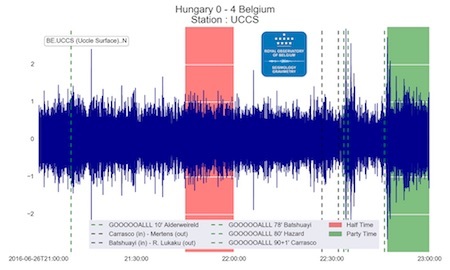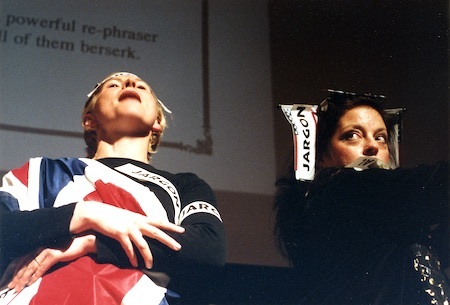Marc Abrahams's Blog, page 263
June 28, 2016
Spin, twin, min, fin, free will, and all that…
 John Conway writes the words SPIN, TWIN, MIN and FIN on a blackboard. Watch him do it, if you will (so to speak), in this video:
John Conway writes the words SPIN, TWIN, MIN and FIN on a blackboard. Watch him do it, if you will (so to speak), in this video:
He then goes on to lecture for an hour (more or less) about his study:
“The Strong Free Will Theorem,” John H. Conway and Simon Kochen, Notices of the AMS [American Mathematical Society], Volume 56, Number 2, February 2009.
What does this mean, you are (or are not) free to wonder. You are not alone. Others have decided, in some fashion, to try to clarify the situation for you. See the study:
“What Does the Free Will Theorem Actually Prove?” Sheldon Goldstein, Daniel V. Tausk, Roderich Tumulka, and Nino Zanghì,” Notices of the AMS [American Mathematical Society], Volume 57, Number 11, December, 2010.
BONUS: Princeton University’s guide to the above video and some related videos, and to your larger adventure in free will exploration.

June 27, 2016
Belgian sporting earthquake measurements project
Scientists in Belgium are methodically measuring the effects of soccer games on the oscillation of the earth. Lieven Scheire alerted us, saying “our seismic institute is measuring small earthquakes every time our national soccer team scores at the european championships.
The image you (probably) see below documents seismic activity from a recent match between Hungary and Belgium. (Belgium won the match, 4-0). The institute explains:
“4-0 ! This picture shows the seismic record of the Uccle Surface station. The first goal is not clearly visible, but the three next triggered a big energy release! Goal-quakes! Belgian Red Devils.”

Sagging pants and the logic of abductive inference
 Not all that many academic studies have examined the possibilities of abductive inference with regard to sagging pants [sagging trousers (UK)]. There are exceptions though. Professor Marcia Morgado of the University of Hawai‘i at Manoa has a paper in the journal Critical Studies in Men’s Fashion (Volume 2 Issue 2-3, September 2015) which:
Not all that many academic studies have examined the possibilities of abductive inference with regard to sagging pants [sagging trousers (UK)]. There are exceptions though. Professor Marcia Morgado of the University of Hawai‘i at Manoa has a paper in the journal Critical Studies in Men’s Fashion (Volume 2 Issue 2-3, September 2015) which:
“[…] explores the usefulness of abductive inference as a conceptual scheme and as a model for thinking about thinking.”
It’s entitled: Uncovered butts and recovered rules: Sagging pants and the logic of abductive inference.
“Peirce’s thesis on abductive inference, which addresses the logic of inferential thinking, frames an interpretive study of a text of heated public arguments that surrounded sagging during its rise as a highly transgressive and controversial subculture appearance form. On the assumption that I could do so, I consciously reconstructed the logic of my inferences, framing these on Peirce’s premise that interpretation begins with an observation (the result) and proceeds to a conclusion regarding meaning (the case) by intuiting a relationship (a hypothesized rule) between the observation and what it appears to mean. The abductions reveal that my inferences were constructed on conventional rules derived from common clichés, principles drawn from scholarly works on the social-psychology of dress, and ordinary marketplace wisdom.”
Image: A partial view of ‘Stop The Sag – Raise Your Pants, Raise Your Image’ as provided by The New York State Senate newsroom.

June 26, 2016
Crud on a Surface: Temperature
Where to begin learning about the effect of “crud” deposits on surface temperature, dry-out and pressure drop, with forced convection boiling of water at 69 bar in an annular test section? A good place to begin is the study:
“An investigation into the effect of ‘crud’ deposits on surface temperature, dry-out and pressure drop, with forced convection boiling of water at 69 bar in an annular test section,” R. V. Macbeth, R. Trenberth, R. W. Wood, volume 42 of Atomic Energy Research Establishment, 1972.

A song for the peoples of Britain, in their hour of dismay
This song, called “Harmonious Misunderstanding”, is the thrilling conclusion to “The Jargon Opera“. The mini-opera premiered as part of the 2002 Ig Nobel Prize ceremony, at Harvard University. That first performance starred singers Margot Button, Jane Tankersley, and Michelle French, and pianist Greg Neil — accompanied gamely by Nobel Laureates Richard Roberts, William Lipscomb, and Dudley Herschbach, and David King, the Chief Scientific Advisor to the British Government. Karen Hopkin narrated. The song was subsequently performed at many Ig Nobel events in the United Kingdom.
Click on this image to see video of that historic first performance. Below are the words to the song.
[MUSIC: Arne’s “Rule, Britannia”. Words by Marc Abrahams.]
They say that better understanding
Would… make us thrive.
But if we knew what others truly want,
We might not wish them to stay alive.
Mis-under-standing may be the thing
That lets us survive.
True understanding… turns people rather shrill.
It really, really, really, makes them want to kill!
[CHORUS:]
Hail to jargon!
‘Tis so eu-pho-ni-ous!
Jar-gon makes misunderstanding harmo’nious!
The Mid-East hag-gl-ing for peace is
Go-ing to fail
‘Till open, clear communication ceases,
As at Harvard, or even Yale.
The trick to dick-er-ing is to fudge on ev’ry detail.
Mis-under-standing… that’s mutu’lly assured
Some-how lets any major diff’rence be endured.
[CHORUS:]
Hail to jargon!
‘Tis so eu-pho-ni-ous!
Jar-gon makes misunderstanding harmo’nious!
The his-to-ry of every nation
Hither and yon,
Is basic’ly a simple compilation
Of how babble defeated brawn.
All armies get exhausted, but jargon just jabbers on.
Jargon is better… than anything around.
It makes your en-e-my suspect his mind’s unsound.
[CHORUS:]
Hail to jargon!
‘Tis so eu-pho-ni-ous!
Jar-gon makes misunderstanding harmo’nious!
The Klingons often fired a phaser
At Captain Kirk.
But Kirk was such a powerful re-phraser
His words made all of them berserk.
The Klingons always fled because they thought, “He’s such a jerk.”
Jargon is better… than anything in space.
It tri-umphs over a con-vention-al arms race.
[CHORUS:]
Hail to jargon!
‘Tis so eu-pho-ni-ous!
Jar-gon makes misunderstanding harmo’nious!
Harmo-ni-ous misunderstanding —
That’s what we need.
Our leaders must use jargon in demanding
We pretend they know how to lead.
Our children must learn jargon before we teach them to read.
True understanding… makes people rather ill —
They’d really, really, really, rather lis-ten to swill!
[CHORUS:]
Hail to jargon!
‘Tis so eu-pho-ni-ous!
Jar-gon makes misunderstanding harmo’nious!
[CHORUS:]
Hail to jargon!
‘Tis so eu-pho-ni-ous!
Jar-gon makes misunderstanding harmo’nious!!
BONUS FACT: The 2002 Ig Nobel Prize ceremony was preceded by a concert by a then-fledgling musical group called the Dresden Dolls.

June 25, 2016
Insiders’ Tell-All About the Dicty World Races
Scientists are not above, nor are they below, indulging in the sport of racing. This new study tells how a bunch of scientists arranged for a bunch of cells to race.
“A Worldwide Competition to Compare the Speed and Chemotactic Accuracy of Neutrophil-Like Cells,” Monica Skoge, Elisabeth Wong, Bashar Hamza, Albert Bae, Joseph Martel, Rama Kataria, Ineke Keizer-Gunnink, Arjan Kortholt, Peter J. M. Van Haastert, Guillaume Charras, Christopher Janetopoulos, Daniel Irimia, PLoS ONE 11(6), 2016: e0154491. The authors report:

“Chemotaxis is the ability to migrate towards the source of chemical gradients…. Because of the complexity of human genetics, Dictyostelium [whose ability to solve puzzles has led to two Ig Nobel Prizes, so far]] and HL60 cells have long served as models system for studying chemotaxis. Since many of our current insights into chemotaxis have been gained from these two model systems, we decided to compare them side by side in a set of winner-take-all races, the Dicty World Races. These worldwide competitions challenge researchers to genetically engineer and pharmacologically enhance the model systems to compete in microfluidic racecourses. These races bring together technological innovations in genetic engineering and precision measurement of cell motility. Fourteen teams participated in the inaugural Dicty World Race 2014 and contributed cell lines, which they tuned for enhanced speed and chemotactic accuracy. The race enabled large-scale analyses of chemotaxis in complex environments and revealed an intriguing balance of speed and accuracy of the model cell lines.”
David Schulzs, writing in Science magazine, profiles the competition. Here’s a promotional video, released two years ago, touting the race:
And here’s video of one of the winners:
(Thanks to Tony Tweedale for bringing this to our attention.)

Evidence from Mozart’s fly swatter, maybe
The Bibliolore blog presents discusses the meaning and import of what may be the remains of a small animal murdered by a famous musical composer:
Franz Niemetschek’s legendary report that La clemenza di Tito was composed in 18 days was not seriously challenged until 1960, when Tomislav Volek published important archival materials relating to the chronology of the opera’s composition. Physical evidence from the autograph manuscript, including the remains of a fly squashed on the paper (probably by the composer in the heat of August), contributes to discrediting the hypothesis that Mozart’s work had begun before he signed his July 1791 contract for the opera.
This according to “The chronology of Mozart’s La clemenza di Tito reconsidered”by Sergio Durante (Music & letters, 80, no. 4 (Nov 1999): 560–594)…

June 24, 2016
Hey Maths! (Beatles studies)
Improbable recently drew attention to ‘Why the Beatles Succeeded but Broke Up: the Math(s)’, now we turn instead to mathematical considerations of the band’s music (rather than of the band itself). In particular, a paper in a Special Beatles Studies issue of the journal Volume !, 2016/1 (12:2) entitled ‘Hey Maths! Modèles formels et computationnels au service des Beatles’
“[…] proposes some thoughts on formal and computational models in and for popular music by focusing on Beatles songs.”
The article can be read in full (for 5€) by clicking the link above. Alternatively, another publication also entitled ‘Hey Maths ! Modèles formels et computationnels au service des Beatles’ (by the lead author Dr. Moreno Andreatta ) may be read free of charge:
 Note: The diagram above shows part of a spacial calculus representation depicting ‘Transformations stylistiques sur les Beatles’.
Note: The diagram above shows part of a spacial calculus representation depicting ‘Transformations stylistiques sur les Beatles’.
Question [optional]: Explain the significance of the topographically re-mapped fish.
Also don’t miss: ‘Les chansons des Beatles dans l’horloge moléculaire’

June 23, 2016
The facial of technology: If it’s super-complicated, it’s impressive!
[WARNING: What you are about to read is super-complicated.]
The most complicated technology is the most impressive technology! That idea fuels some of technology’s most impressive investment and marketing campaigns. You can see it in action, and judge its worth, when you look at Faceception.
What is Faception? Faception is a company. Faception is a technology. Faception is an exciting investment opportunity. Faception says its machine can detect a person’s personality by looking at that person’s face. The Faception web site explains:
We reveal personality from facial images at scale to revolutionize how companies, organizations and even robots understand people and dramatically improve public safety, communications, decision-making, and experiences.
Faception has an impressive “Theory Behind the Technology”. That theory is based on complicated logic that’s based on complicated interpretations of complicated research observations.
You may find that Faception’s complicated logic that’s based on complicated interpretations of complicated research observations is the very most impressive thing about Faception. Here’s Faception’s explanation of The Theory Behind the Technology:
The face can be used to predict a person’s personality and behavior. This claim relies on a combination of two known research observations:
1. According to Social and Life Science research personalities are affected by genes.
2. Our face is a reflection of our DNA
While these type of affirmations are quite recent, in Chinese history, there have been people that have studied the “mapping of the face” for thousands of years
If all this does not impress you, there is something wrong.
BONUS: Here’s video of the company’s founder making a “pitch” for investors. Prepare to be impressed:
(Thanks to Andy Aaron for bringing this to our attention.)

The most attractive navel position – where is it exactly?
“The aim of this study is to analyze the navel position and shape of the worldwide top model/celebrities recognized as top 2013 bikini models to determine references for ideal navel shape and positioning and to find potential clinical translation.”
– explain authors Giuseppe Visconti, Emiliano Visconti, Lorenzo Bonomo and Marzia Salgarello regarding their 2015 navel-based research paper for the journal Aesthetic Plastic Surgery.
Their study comprised three parts,
○ A quantitative study of the navel surface anatomy in 81 top 2013 bikini models by analyzing four proportions:
○ An analysis of navel shapes in 81 top 2013 bikini models was recorded and classified based on previous study of Craig SB et al.
○ An on-line survey via facebook.com made of seven multiple-choice questions, involving 1,682 invited people unaware of our concepts in navel aesthetic. [see photo]
“Conclusion.
The most attractive navel position is located at the xiphoid–umbilicus : umbilicus-abdominal crease golden ratio. Bony landmarks seem to be not reliable as references for proper navel positioning. The use of the Fibonacci (golden mean) caliper intraoperatively might aid in proper positioning of the navel in abdominoplasty.” [our hyperlinks]
As mentioned above, the team not only examined the ‘most attractive position’ but also the general morphology of the navel :
“The vertical oval shape, the presence of superior hooding, and the absence of protrusion are the main features that make a navel attractive for human eyes, confirming conclusions from other navel shape studies.”
See: Concepts in Navel Aesthetic: A Comprehensive Surface Anatomy Analysis, Aesthetic Plastic Surgery, February 2015, Volume 39, Issue 1, pp 43-50
Also see: In search of the “beautiful” umbilicus and Divine Proportions in male nipple re-positioning.

Marc Abrahams's Blog
- Marc Abrahams's profile
- 14 followers








